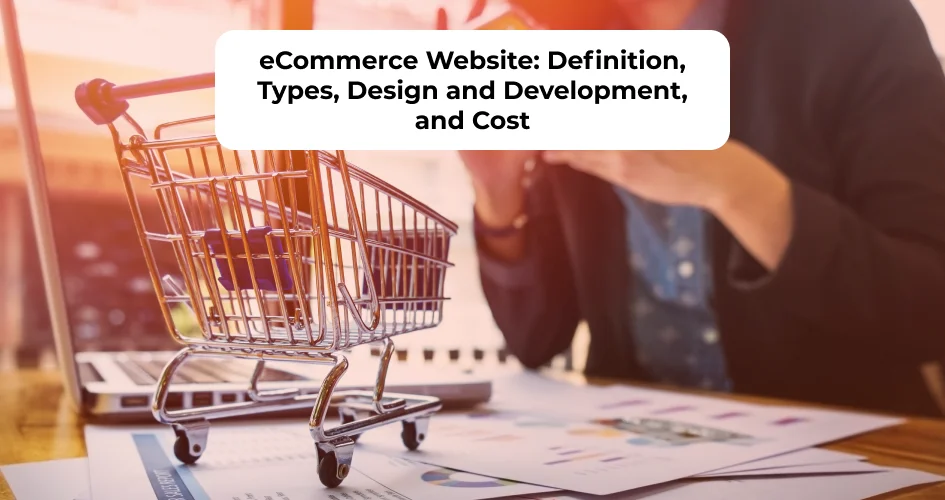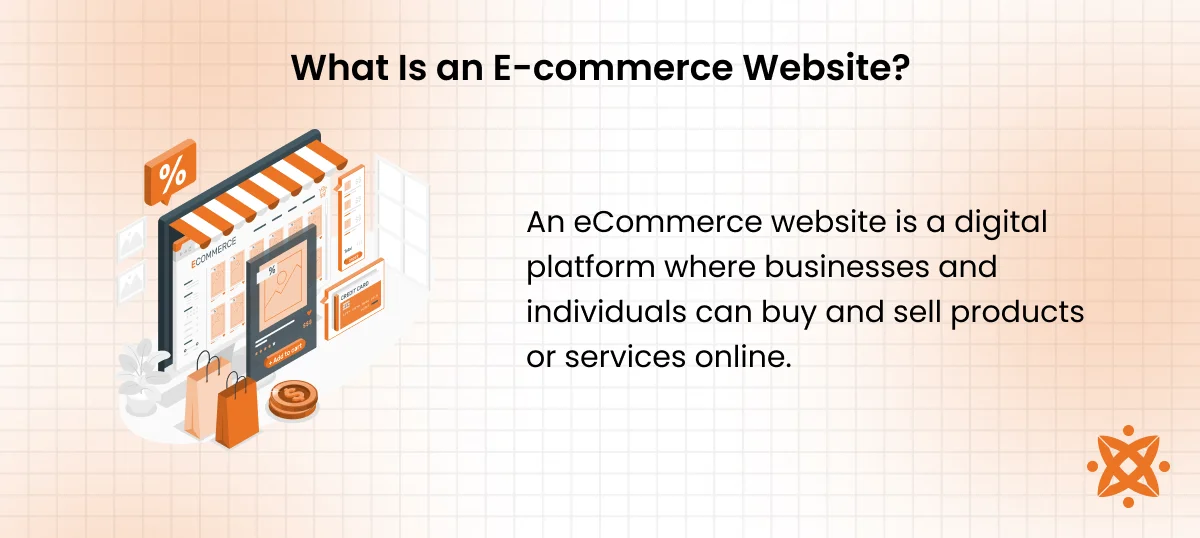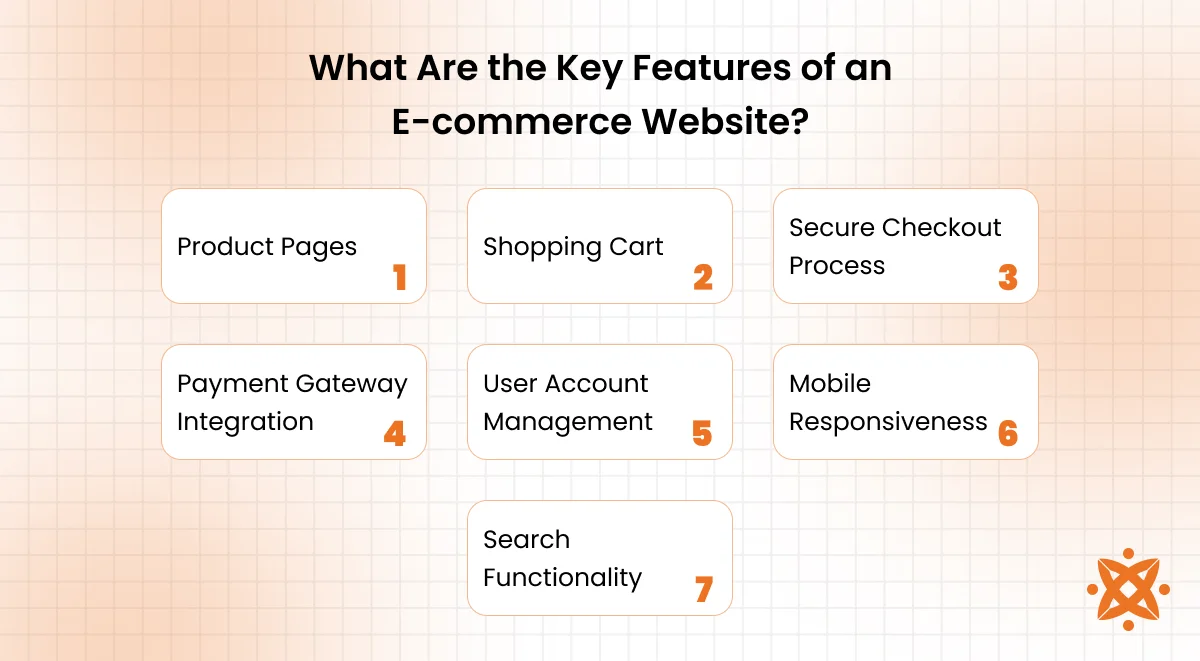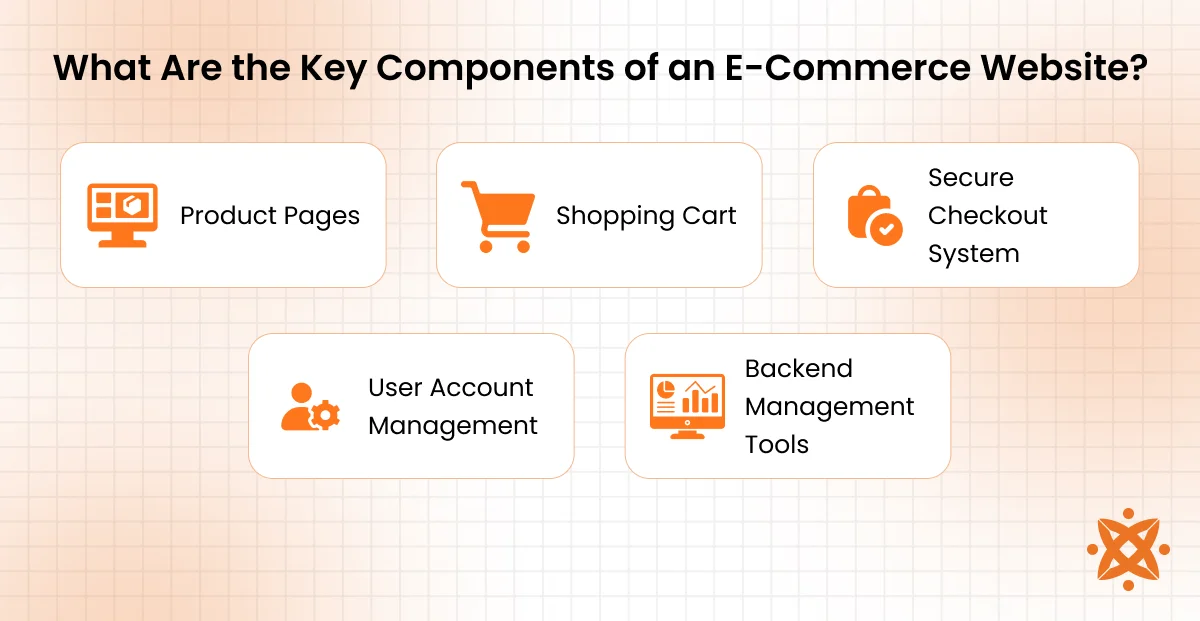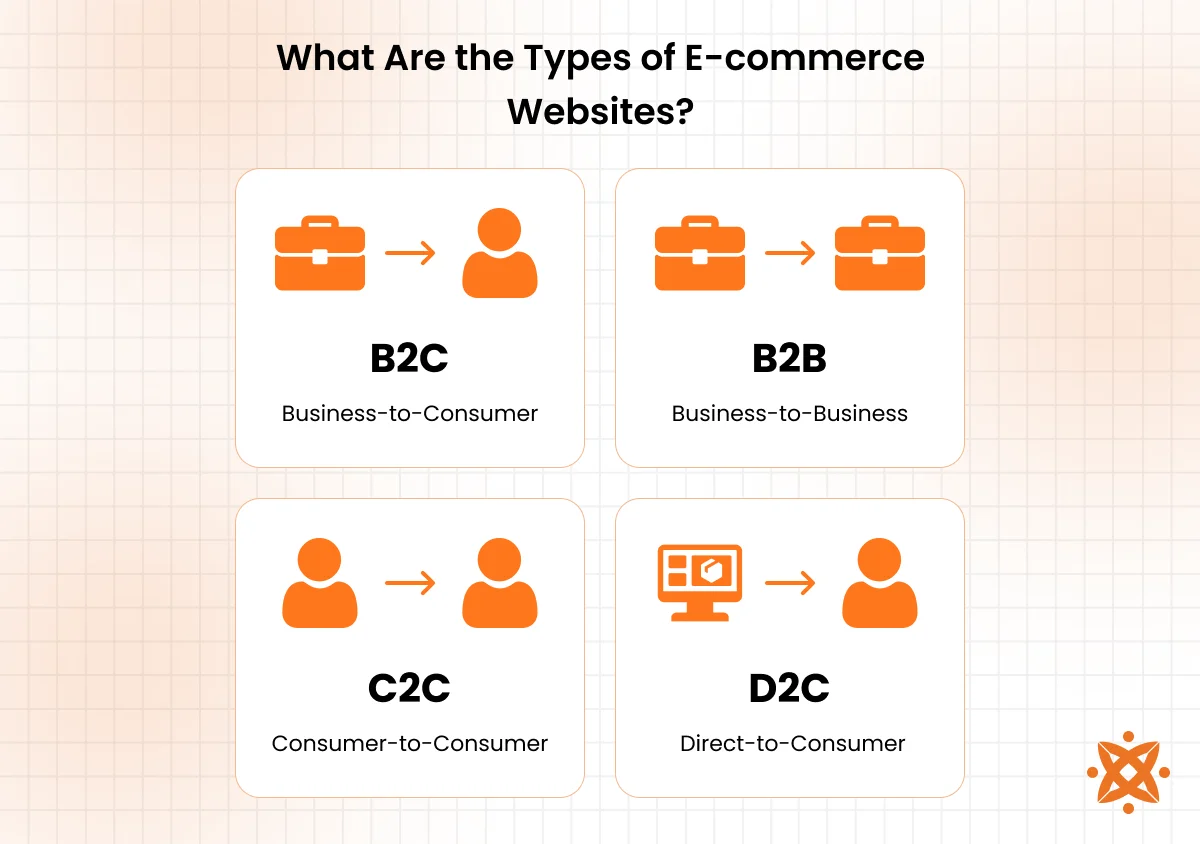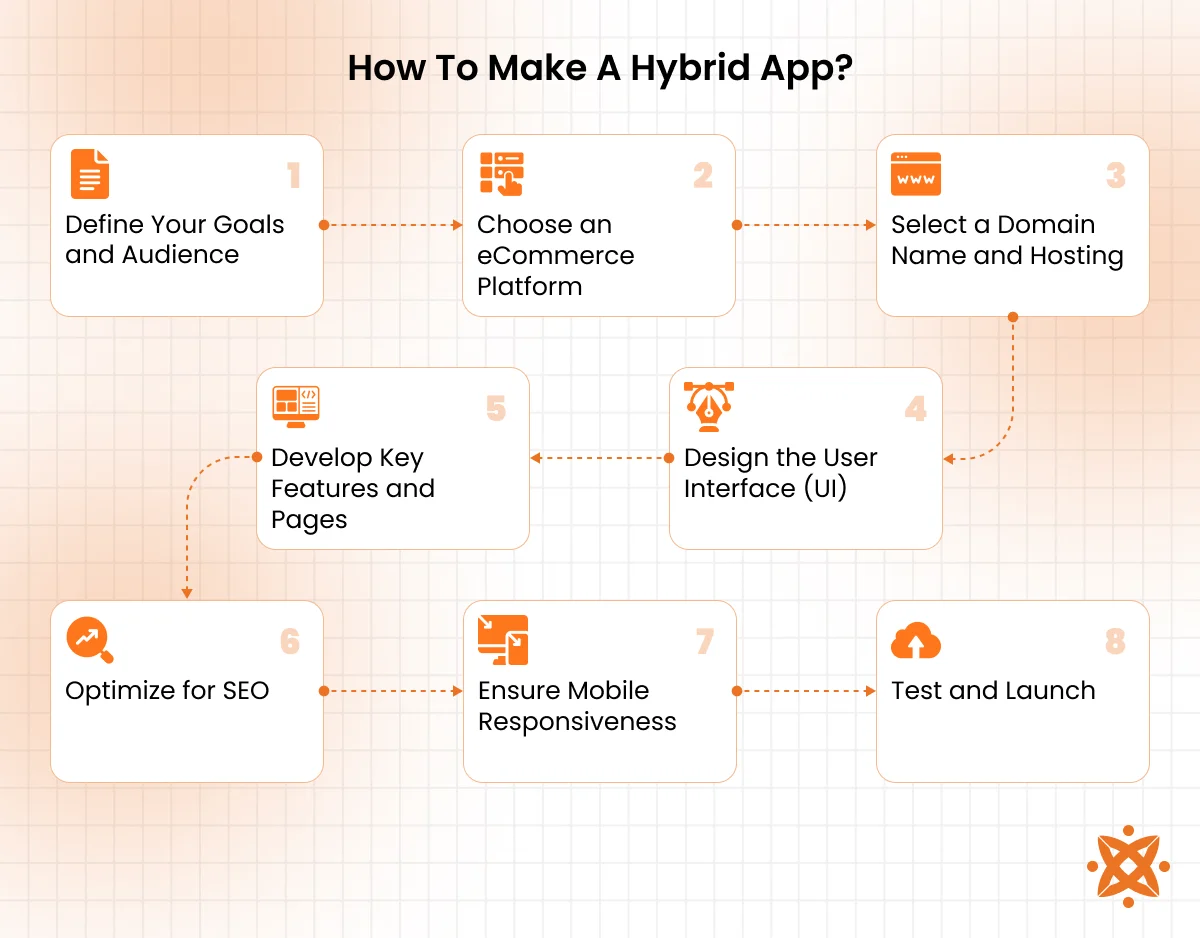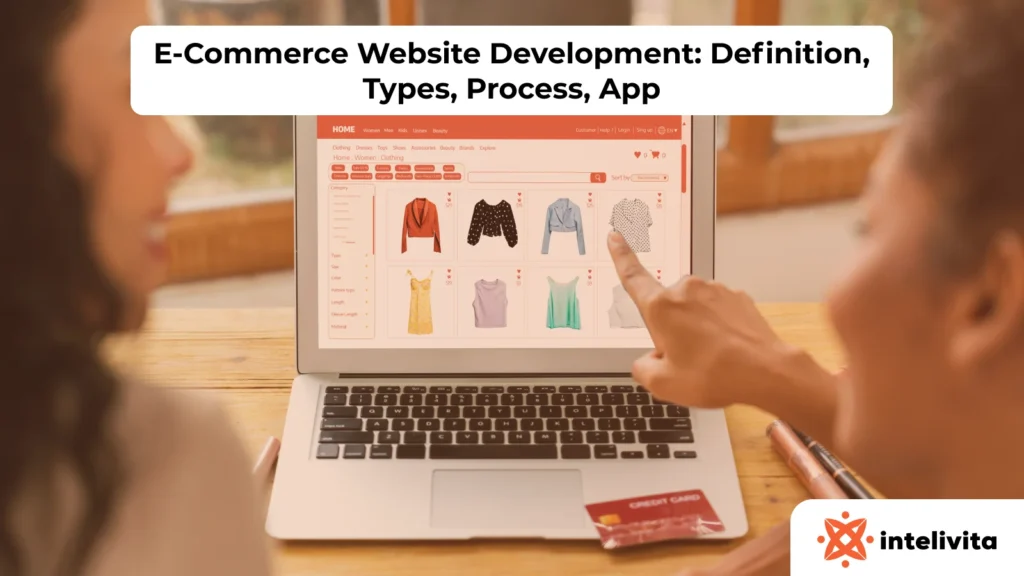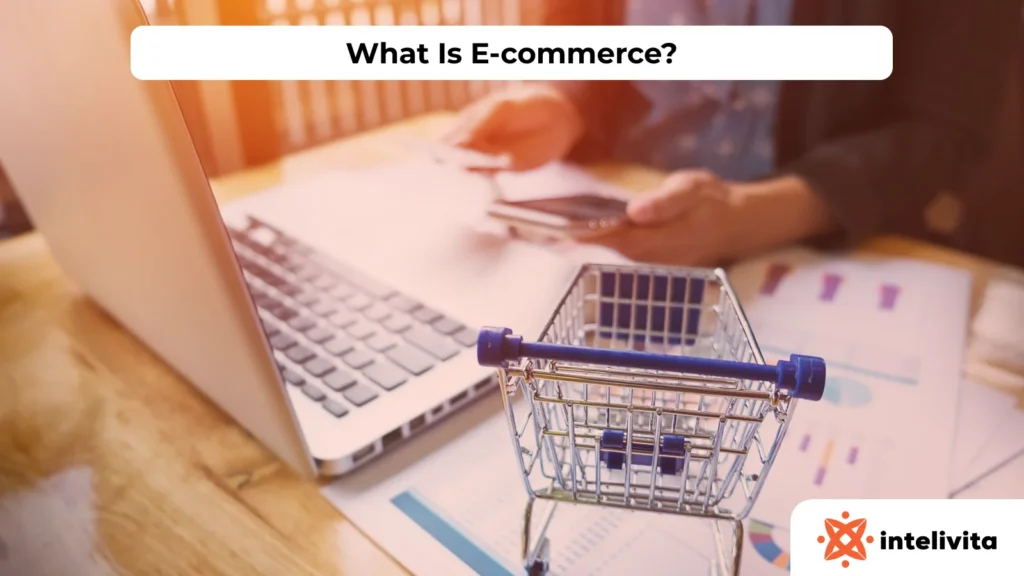An eCommerce website is an online platform where businesses sell products or services directly to consumers over the internet. It allows users to browse products, add them to a cart, make payments, and receive orders without visiting a physical store.
The main purpose of an eCommerce website is to ease buying and selling online, offering convenience, reach, and scalability for businesses and consumers. It enables 24/7 transactions and supports global access to goods and services.
Key features of an eCommerce website include product catalogs, shopping carts, secure payment gateways, user accounts, and order tracking. These features work together to deliver a smooth online shopping experience.
The core components of an eCommerce website are the homepage, product pages, shopping cart, checkout process, payment gateway integration, user account system, and mobile responsiveness. Other essentials include search functionality, customer reviews, analytics tools, and secure hosting.
The types of eCommerce websites include B2B (Business-to-Business), which sell products or services to other businesses, e.g., Alibaba. B2C (Business-to-Consumer), where companies sell directly to consumers, e.g., Amazon. C2C (Consumer-to-Consumer) where consumers sell to other consumers through platforms like eBay. C2B (Consumer-to-Business) where individuals offer services to businesses, such as on Upwork.
Designing and developing an eCommerce website requires careful planning around user experience (UX), mobile optimization, and payment integration. A successful online store must be easy to navigate, fast-loading, and secure across all devices.
The cost of developing an eCommerce website ranges from $500 for basic template-based setups to over $50,000 for custom-built, feature-rich platforms. Ongoing costs like hosting, maintenance, SEO, and marketing should also be factored in
What Is an E-commerce Website?
An eCommerce website is a digital platform where businesses and individuals can buy and sell products or services online. It serves as a virtual storefront, allowing users to browse product listings, add items to a shopping cart, make payments through secure gateways, and track their orders, all without setting foot in a physical store.
A typical eCommerce website includes essential features such as detailed product listings, customer accounts, shipping options, real-time inventory updates, and payment gateways like PayPal, Stripe, or credit card processors. These tools work together to create a smooth and secure shopping experience for both buyers and sellers.
There are different types of eCommerce models, each serving a unique audience. Business-to-Business (B2B) platforms connect companies that sell products or services to other businesses.
Business-to-Consumer (B2C) sites cater directly to individual buyers. Consumer-to-Consumer (C2C) websites, like eBay, allow individuals to trade or sell to one another, while Direct-to-Consumer (D2C) models let manufacturers sell directly to the end customer without third-party retailers.
You’ve probably interacted with major eCommerce platforms already, Amazon for everything from electronics to groceries, eBay for second-hand items and auctions, and Shopify for thousands of independent online stores.
In today’s digital economy, eCommerce websites do more than just process orders. They drive global commerce, support small business growth, and make it easier for consumers to access goods from anywhere. Whether you’re a shopper in New York or a seller in Lagos, a digital marketplace connects you to global opportunities in just a few clicks.
What Is the Purpose of an E-commerce Website?
The primary purpose of an eCommerce website is to enable the online buying and selling of products or services. It acts as a 24/7 storefront where customers explore items, compare prices, read reviews, and place orders from the comfort of their homes, anytime, anywhere.
For businesses, an eCommerce website serves as a scalable sales channel. It reduces the need for physical retail space and allows you to reach customers across cities, countries, or even continents. You list new products instantly, test marketing strategies in real time, and gather data to better understand customer behavior.
From a customer’s perspective, the goal of an eCommerce website is convenience. Whether it’s purchasing groceries, booking a service, or downloading digital products, the process is fast and efficient. With features like personalized recommendations, secure payment options, and order tracking, users enjoy a seamless shopping experience.
An eCommerce site also plays a vital role in building brand identity and trust. A well-designed site reflects professionalism, while integrated features like customer reviews, live chat, and clear return policies enhance credibility and customer satisfaction.
In short, the purpose of an eCommerce website goes beyond simple transactions, it’s about delivering value, convenience, and trust in a digital environment.
What Are the Key Features of an E-commerce Website?
The key features of an eCommerce website are product pages, a shopping cart, a secure checkout process, payment gateway integration, user account management, mobile responsiveness, and search functionality.
- Product Pages: Product pages display each item with its images, price, description, and availability. This helps shoppers understand what they’re buying and make informed decisions. A clear layout with reviews and specs improves trust and reduces abandoned carts.
- Shopping Cart: The cart lets users collect and review selected items before checkout. It should support quantity changes, item removal, and show total costs. A persistent cart, like Amazon’s, encourages users to return and complete purchases later.
- Secure Checkout Process: The checkout collects customer information and processes the order. Fewer steps and guest checkout options help reduce drop-offs. A short, clear form with progress indicators makes the process easier to complete.
- Payment Gateway Integration: Payment gateways process the transaction securely. Popular options include PayPal, Stripe, and credit cards. Multiple payment choices increase the chance of conversion by matching user preferences.
- User Account Management: User accounts save addresses, order history, and wish lists. Logged-in users get faster checkouts and order tracking. Accounts also support email updates and product recommendations based on past activity.
- Mobile Responsiveness: A responsive site adjusts to phones and tablets without breaking layout or functions. Over 60% of online shopping happens on mobile, so every page must load quickly and work smoothly across screen sizes.
- Search Functionality: A search bar helps users find products without browsing every page. Filters, sorting options, and suggestions improve speed and accuracy. Sites like Walmart or Target use this to increase conversion from search users.
What Are the Key Components of an E-Commerce Website?
The key components of an e-commerce website are product pages, a shopping cart, a secure checkout system, user accounts, and backend management tools. These elements work together to handle everything from browsing and payment to inventory tracking and order fulfillment.
The key features of an e-commerce website are explained below:
- Homepage: Your homepage is the front door of your online store. It introduces your brand, showcases featured products or promotions, and guides users through the site with clear navigation. A clean, engaging homepage builds instant credibility and encourages exploration. Just look at how Amazon or Walmart does it.
- Product Pages: These pages display individual products with essential details like images, descriptions, pricing, and availability. A strong product page includes specs, size guides, and customer reviews to help users make informed decisions. According to Baymard Institute, 56% of users abandon a purchase if product information is unclear or insufficient.
- Shopping Cart: The cart allows users to save selected items and review their choices before checking out. It should support easy edits like removing products, adjusting quantities, and calculating totals. Sites like Target and Best Buy offer persistent carts so customers can return later and complete their purchase.
- Checkout Process: This is where the purchase happens, so it needs to be smooth and secure. A good checkout minimizes steps, asks only for essential info, and offers guest checkout options. Long or confusing checkout forms are a leading cause of cart abandonment.
- Payment Gateway Integration: Secure payment gateways like Stripe, PayPal, or Square handle the actual transaction. They ensure sensitive data is encrypted and processed according to global standards. Offering multiple payment methods improves conversion rates by catering to user preferences.
- User Account Management: User accounts store personal info, order history, shipping addresses, and wish lists. They enhance the experience by enabling faster checkouts, personalized product recommendations, and email alerts. For example, logged-in users on Etsy track orders or favorite shops.
- Search Functionality: A strong search tool helps customers quickly find what they’re looking for. It should include filters, sorting options, and auto-suggestions to improve usability. Studies show that users who use site search are 2–3 times more likely to convert.
- Product Categories: Categories organize items into logical groups (e.g., Men’s Clothing, Electronics, or Home Goods). They simplify navigation and improve SEO by targeting category-level keywords. Clear category labels like those on Wayfair or Zappos make browsing easy and intuitive.
- Customer Reviews and Ratings: These build trust by letting buyers share their experiences with a product. Honest reviews influence new customers and help reduce return rates.
- Security Features: SSL certificates, encrypted payment systems, and secure hosting protect users and transactions. Trust signals like “Secure Checkout” or padlock icons encourage users to complete their orders.
- Mobile Responsiveness: Your site must work flawlessly on phones and tablets. A responsive design adapts to any screen size without breaking layout or functionality. Over 60% of online shopping traffic now comes from mobile devices, according to Statista.
- Customer Support: Support tools like live chat, FAQs, and contact forms help users resolve issues fast. Immediate assistance reduces friction and improves satisfaction. Shopify and Apple, for example, offer real-time support to keep customers engaged and confident.
- Analytics and Reporting: Tracking tools like Google Analytics help you monitor traffic, sales, and user behavior. These insights drive smarter marketing, product placement, and design decisions. Without analytics, you’re flying blind in a highly competitive space.
- Marketing and SEO Tools: These include features like meta tags, sitemaps, promotional banners, and email marketing integration. Good SEO helps users discover your store through Google, while marketing tools help bring them back. Platforms like Shopify and BigCommerce offer built-in tools for both.
- Shipping and Return Policies: Clearly stated policies reduce friction and improve buyer confidence. Offer multiple shipping options and outline how returns work to avoid confusion. Zappos, for instance, is known for generous return terms that build trust and loyalty.
What Are the Types of E-commerce Websites?
The types of e-commerce websites are Business-to-Consumer (B2C), Business-to-Business (B2B), Consumer-to-Consumer (C2C), and Direct-to-Consumer (D2C). Each model serves a unique purpose, from companies selling directly to individual shoppers, to platforms like eBay that allow individuals to trade goods with each other.
Below are the main types of e-commerce websites, each with real-world examples to help you understand how they work.
Business-to-Consumer (B2C)
B2C websites are the most common type of eCommerce platforms, where businesses sell directly to everyday consumers. Think of Amazon, Walmart, or Target. These sites let you buy electronics, clothes, groceries, and more with just a few clicks.
These platforms focus on easy navigation, product variety, and a smooth checkout experience. For most online shoppers, this is the standard eCommerce setup. B2C sites prioritize customer experience, fast delivery, and flexible return policies.
Business-to-Business (B2B)
B2B websites are built for transactions between companies. For example, manufacturers or wholesalers sell their goods or services to other businesses through platforms like Alibaba and ThomasNet.
These websites deal in bulk orders, custom pricing, and long-term contracts. B2B transactions involve more negotiation and invoicing features than B2C. The goal is to simplify procurement and scale supply chains efficiently.
Consumer-to-Consumer (C2C)
C2C platforms let individuals sell directly to one another. Popular examples include eBay, Craigslist, and Facebook Marketplace. These websites act as intermediaries, helping users list items, connect with buyers, and complete transactions safely. They’re ideal for second-hand goods, collectibles, or peer-to-peer services. Trust-building features like ratings and reviews are especially important here.
Consumer-to-Business (C2B)
In C2B models, individuals offer products or services to businesses. Freelance platforms like Upwork and Fiverr are classic examples—where writers, designers, and developers sell their services to companies.
C2B model flips the traditional business-consumer relationship by putting individuals in the seller’s seat. It’s especially useful for remote work, creative services, and consulting. Companies benefit from flexible talent pools, while individuals gain access to global clients.
Business-to-Government (B2G)
B2G platforms connect private companies with government agencies. Businesses use these platforms to bid on contracts, supply goods, or provide services like software or construction. FedBid (now Unison Marketplace) is a major example in the U.S.
These sites must meet strict compliance standards and typically include features for bidding, documentation, and contract management. B2G eCommerce simplifies procurement for government agencies and opens new revenue streams for businesses.
Government-to-Business (G2B)
G2B websites are used by governments to deliver information, collect taxes, or issue licenses to businesses. These platforms help streamline compliance and regulatory processes. For instance, a state government site that allows business license renewals or environmental permit applications falls into this category. G2B platforms improve transparency and reduce paperwork. They’re essential for efficient governance and business regulation.
Government-to-Consumer (G2C)
G2C platforms serve the public by offering services directly from government bodies. These can include websites where citizens pay utility bills, renew driver’s licenses, or access public healthcare info.
Examples of G2C websites include IRS.gov for tax filing or healthcare.gov for insurance enrollment. G2C platforms aim to simplify civic processes and increase digital access. In essence, they bring essential public services online.
Direct-to-Consumer (DTC or D2C)
DTC websites allow brands to sell their products straight to consumers, cutting out third-party retailers. This model gives businesses full control over branding, pricing, and customer relationships.
Examples of DTC websites include Warby Parker, Glossier, and Allbirds—brands that operate entirely online and market directly to their audience. DTC enables more personalization and higher profit margins. It’s a growing trend, especially among startups and niche brands.
Subscription-Based E-commerce
This model delivers products or services on a recurring basis, usually monthly or quarterly. Companies like Dollar Shave Club and Netflix are subscription eCommerce leaders. The goal is to build customer loyalty through convenience and value.
Subscription eCommerce requires consistent service, automated billing, and flexible cancellation options. It’s ideal for consumables, digital services, or content platforms.
Dropshipping
Dropshipping is a fulfillment model where the seller doesn’t hold inventory. Instead, products are shipped directly from the supplier to the customer. Shopify-based stores and platforms like Oberlo have made dropshipping widely accessible. This model reduces upfront costs but requires strong supplier relationships and customer service. It’s a low-barrier entry into eCommerce for new entrepreneurs.
How Does A Subscription Service E-commerce Website Function?
A subscription service eCommerce website functions by providing products or services to customers on a recurring schedule, usually monthly or annually. Instead of making one-time purchases, users pay at regular intervals for continued access to goods or services. This model is designed around consistency, automation, and long-term engagement.
Customers start by creating an account on the website, where they can manage subscriptions, view billing history, pause or cancel services, and update preferences. These user dashboards are necessary for building trust and giving subscribers control over their experience.
Most subscription websites offer multiple plans or tiers—each with different features, delivery frequency, or pricing. For instance, a meal kit service might let you choose between weekly, bi-weekly, or family-sized plans. This flexibility allows businesses to serve a wide range of customer needs.
Automated billing is a core feature. The site securely stores payment info and charges subscribers automatically at the start of each cycle. This ensures continuous service and eliminates the friction of repeated manual payments.
Delivery or access happens either digitally or physically. For example, Netflix and Spotify offer instant content streaming, while companies like Dollar Shave Club and Blue Apron ship physical boxes to your door on a set schedule. In both cases, the delivery is tied directly to the active subscription.
To keep users engaged and reduce churn, businesses often offer perks like exclusive content, early access to new features, loyalty rewards, or discounts for committing to long-term plans. These strategies improve retention and build stronger customer relationships.
Popular examples of subscription eCommerce websites include Netflix (entertainment), Spotify (music), Dollar Shave Club (grooming), and Blue Apron (meal kits). These brands show how the model works across industries.
For businesses, the subscription model means predictable revenue and stronger customer insights. For customers, it offers convenience, personalization, and ongoing value without the need to reorder constantly.
How To Develop an E-commerce Website Step by Step?
The steps to design and develop an eCommerce website are planning, platform selection, design and development, product setup, payment integration, testing, and launch. Each step to develop an e-commerce website ensures the website is functional, user-friendly, secure, and ready to handle transactions and scale over time.
The following are steps to develop an e-commerce website
Step 1: Define Your Goals and Audience
The first step in designing an eCommerce website is to define your goals and identify your target audience to ensure the site meets their expectations. Understanding your business objectives and customer needs helps shape the website’s design, content, and features. Whether you’re targeting price-sensitive shoppers or premium buyers, clarity here guides every decision that follows.
Step 2: Choose an eCommerce Platform
Selecting the right platform is critical. Options like Shopify (for ease and speed), WooCommerce (for WordPress users), and Magento (for large, custom projects) each offer unique benefits. The right platform depends on your budget, technical skill, and scalability needs.
Step 3: Select a Domain Name and Hosting
Choose a short, brandable domain name that’s easy to remember and reflects your business. Pair it with a reliable hosting provider that ensures fast loading times, uptime, and security. Your website’s performance plays a big role in user satisfaction and SEO ranking.
Step 4: Design the User Interface (UI)
The design should be clean, easy to navigate, and aligned with your brand. Use a cohesive layout, color scheme, and typography that creates a pleasant shopping experience. Most platforms offer customizable themes to help you get started quickly.
Step 5: Develop Key Features and Pages
Include all essential pages like the homepage, product listings, product detail pages, shopping cart, and checkout. Important features include site search, secure payment integration, shipping options, and user accounts. These elements support the entire buying journey from browsing to purchase.
Step 6: Optimize for SEO
Use relevant keywords in your product descriptions, meta tags, and URLs to boost search engine visibility. Add schema markup and generate an XML sitemap to help Google index your site properly. SEO brings in organic traffic and reduces reliance on paid ads.
Step 7: Ensure Mobile Responsiveness
Your website must look and function well on all screen sizes. With more than half of online traffic coming from mobile devices, a responsive design isn’t optional—it’s essential. Test on multiple devices to ensure smooth navigation and fast loading.
Step 8: Test and Launch
Before launching, test all site functions including checkout, forms, speed, and mobile compatibility. Fix any bugs and ensure your security protocols (like SSL certificates) are in place. Once everything is ready, go live and monitor performance closely.
Is A Marketplace Website Better than an E-commerce Website for Sellers?
No, a marketplace website is not better for sellers than an eCommerce website. The best choice depends on the seller’s goals, resources, and long-term business strategy.
Marketplace websites like Amazon, Etsy, or eBay come with a built-in audience, which means more exposure from day one. They provide essential tools like payment processing, customer service support, and fulfillment options, making it easier to start selling without any web development experience. Plus, marketplaces carry consumer trust, which helps new sellers convert more quickly.
On the other hand, having your own eCommerce website gives you complete control. You shape your brand identity, customize the user experience, and build long-term relationships with your customers. No listing or transaction fees are cutting into your profit margins, and you get full access to customer data, allowing for better retargeting, personalized emails, and loyalty campaigns.
When comparing the two, marketplaces win on visibility and convenience, while standalone stores offer more control, brand equity, and growth potential. Marketplaces are great for testing products or gaining traction quickly. But for sellers looking to scale and build a long-term brand, owning a dedicated eCommerce site is often the smarter move.
How Does User Experience Impact E-commerce Website Design?
User experience (UX) impacts eCommerce website design in nearly every way, from how quickly visitors find products to how confident they feel completing a purchase. A well-designed UX makes the site feel easy, trustworthy, and enjoyable to use, qualities that directly affect whether a visitor becomes a paying customer. When users navigate smoothly, load pages quickly, and interact with clear calls-to-action, their satisfaction rises, and so do your conversions.
Good UX design means a responsive website with intuitive navigation, mobile responsiveness, and fast website speed, all essential for reducing bounce rates and cart abandonment. Customers are more likely to stay, explore, and buy when they aren’t frustrated by cluttered pages, broken buttons, or slow load times. Clear design and easy checkout flow also build trust, which is key for first-time buyers.
UX also affects key performance indicators (KPIs) like conversion rate, time on site, and average order value. When users easily search, filter, and compare products, they’re more likely to engage with the store and complete a purchase.
What Is The Cost of Developing an E-commerce Website?
The cost of developing an eCommerce website ranges from $1500 to over $30,000, depending on the platform, features, and level of customization. A basic store built with a prebuilt theme on Shopify or WooCommerce can be launched for under $1,000, while a fully custom, enterprise-level solution can run into tens of thousands of dollars.
Custom designs cost more than prebuilt themes because they involve tailored layouts, brand-specific visuals, and flexible user experiences. However, they offer greater control and scalability, making them a smart investment for businesses with long-term growth plans.
The complexity of your website plays a major role in an e-commerce website development cost. Features like advanced payment gateways, large product catalogs, user accounts, multilingual support, or third-party integrations all require more development time and resources. For instance, a site with 500+ products and custom checkout logic will cost far more than a simple store with 20 items and standard payment options.
Your platform choice also affects pricing. Shopify has predictable monthly fees and a user-friendly setup, while WooCommerce (built on WordPress) is more customizable but requires more hands-on work. Custom-coded platforms like Magento or headless CMS solutions are powerful but usually come with higher development and maintenance costs.
Hiring a freelancer may cost less upfront, while in-house teams provide more control but come with salary and infrastructure expenses. Outsourcing to an agency gives you access to a full team but commands higher fees for strategy, design, and execution.
Beyond initial development, there are ongoing costs to consider: hosting, site maintenance, updates, security patches, and plugins or app subscriptions. Don’t forget the cost of SEO services, content creation, advertising, and analytics tools, all of which are needed for driving traffic and conversions.
Is Website Maintenance A Significant Expense for E-commerce Websites
Yes, website maintenance is a significant expense for eCommerce websites, and it’s a necessary one to ensure long-term performance, security, and customer trust.
Website maintenance includes tasks like updating plugins, fixing bugs, backing up data, improving speed, and monitoring uptime, all of which directly affect how smoothly your site runs.
Regular maintenance prevents downtime, protects against security threats, and keeps your site compatible with new technologies and browser updates. For eCommerce websites that handle transactions and store customer information, staying updated isn’t optional—it’s essential.
Maintenance costs vary depending on your platform and setup. For example, Shopify handles most updates internally, keeping maintenance costs low. In contrast, WooCommerce or custom-built sites require developers to manage updates, fix issues, and monitor performance regularly, which adds to monthly expenses.
Ongoing maintenance can range from $50 to $500+ per month, depending on the complexity of your website. Skipping maintenance leads to lost sales, broken features, and security breaches—issues that cost far more to fix after the fact than to prevent upfront.
Are Custom Designs More Beneficial than Prebuilt Themes for E-commerce Websites?
Yes, custom designs are more beneficial than prebuilt themes for eCommerce websites because they offer greater flexibility, uniqueness, and alignment with your brand identity. With a custom design, you’re not limited by the structure or style of a generic template—you can shape every element to reflect your business values, product types, and customer expectations.
Custom designs also enhance user experience by allowing you to build intuitive navigation, tailored product pages, and unique checkout flows that fit your audience. This level of control can significantly improve conversion rates, SEO performance, and customer satisfaction.
While prebuilt themes are more cost-effective and allow for faster deployment, they often come with limitations in scalability, layout control, and feature integration. Many businesses outgrow templates quickly as their operations expand or when they need more advanced functions.
In contrast, custom designs are built with long-term growth in mind. They adapt better to future updates, integrate smoothly with third-party tools, and offer better performance across devices. For businesses serious about standing out in a crowded market, investing in custom design delivers both immediate branding impact and long-term strategic value.
Is Website Maintenance A Significant Expense for E-commerce Websites?
Yes, website maintenance is a significant expense for eCommerce websites, and it’s a necessary one to ensure long-term performance, security, and customer trust. Maintenance includes tasks like updating plugins, fixing bugs, backing up data, improving speed, and monitoring uptime, all of which directly affect how smoothly your site runs.
Ongoing maintenance ranges from $50 to $500+ per month, depending on the complexity of your website. Skipping maintenance can lead to lost sales, broken features, and security breaches, issues that cost far more to fix after the fact than to prevent upfront.
Regular maintenance prevents downtime, protects against security threats, and keeps your site compatible with new technologies and browser updates. For eCommerce websites that handle transactions and store customer information, staying updated isn’t optional, it’s essential.
Maintenance costs vary depending on your platform and setup. For example, Shopify handles most updates internally, keeping maintenance costs low.
How Does an E-commerce Website Differ from a Traditional Website?
An eCommerce website differs from a traditional website primarily in its functionality, purpose, and features. While a traditional website is usually informational, used to share content, showcase a portfolio, or present company details; an eCommerce site is built for transactions. Its core purpose is to sell products or services online, which requires additional layers of functionality and complexity.
In terms of features, eCommerce websites include transactional tools like shopping carts, payment gateways, product catalogs, inventory management systems, and secure checkout processes.
Traditional websites, by contrast, have contact forms or downloadable content but rarely support end-to-end transactions. According to a 2023 Statista report, 21% of global retail sales now happen online.
The user experience also differs significantly. eCommerce sites must provide smooth navigation, real-time product availability, customer login areas, and fast, mobile-friendly interfaces to guide users through the entire shopping journey.
A Baymard Institute study shows that 69.82% of online shopping carts are abandoned, due to poor UX, highlighting how critical a frictionless experience is for eCommerce success.
Are E-commerce Websites Necessary for All Types of Businesses?
No, eCommerce websites are not necessary for all types of businesses, but they are essential for those that sell physical or digital products and aim to reach a broader, global, customer base.
Whether an eCommerce website is needed depends on the business model, target market, product type, and whether the online channel offers a measurable competitive advantage.
For businesses selling physical goods, such as fashion, electronics, or homeware, an eCommerce platform opens access to online shoppers, streamlines inventory management, and enables automated order processing.
According to Shopify, 56% of consumers prefer shopping online over in-store, making digital presence vital for retail growth. Similarly, service-based businesses that offer digital products or subscriptions benefit from the scalability and automation eCommerce websites provide.
However, for businesses that rely on face-to-face interactions, such as local barbershops, repair services, or B2B consultancies, a full eCommerce site may not offer enough return on investment. These businesses often benefit more from informational websites with basic contact and booking features.
Ultimately, the necessity of an eCommerce website depends on the nature of the product, customer buying behavior, and whether online transactions enhance business value.
How Does Mobile Commerce Compare to Traditional E-commerce in Terms of Growth?
Mobile commerce compares with traditional eCommerce in both speed and scale of growth, and it’s outpacing the latter across nearly every key metric. Fueled by rising smartphone penetration and a growing preference for convenience, mobile commerce (m-commerce) has become the dominant force behind global eCommerce expansion.
According to Insider Intelligence, mobile commerce accounted for 60% of all eCommerce sales in the U.S. in 2023 and is projected to surpass $710 billion by 2025.
M-commerce growth is especially strong in sectors like fashion, food delivery, and entertainment, industries that benefit from impulse buying and real-time accessibility. Consumers now prefer to shop on mobile apps during commutes, breaks, or while multitasking, rather than waiting to sit at a computer. This shift in behavior has made mobile-first design and app-based shopping experiences a top priority for businesses.
Mobile commerce also benefits from features that improve customer experience and boost conversions, including push notifications, one-click checkouts, and location-based offers. Apps like Amazon, DoorDash, and SHEIN have shown how personalized, responsive mobile experiences drive customer loyalty and repeat purchases.
Are Data Security Concerns More Critical Now Than Before in E-commerce?
Yes, data security concerns are more critical now than ever before in eCommerce, as the rapid increase in online transactions has made digital stores prime targets for cybercriminals. Global eCommerce sales grew by 9.7% in 2023 to $5.78 trillion, increasing the volume of sensitive data flowing through websites and amplifying security risks
E-commerce sites process vast amounts of personal and financial information—names, addresses, credit card numbers, and more—making them attractive to hackers. In 2024, the average cost of a data breach reached $4.88 million, highlighting the high stakes of compromised customer data. Common cyber threats include phishing, and DDoS attacks.
To combat these threats, eCommerce platforms must comply with global regulations like GDPR and PCI-DSS, which set strict standards for data handling and payment security. SSL/TLS encryption secures data in transit between customers and servers, while two-factor authentication (2FA) adds an extra layer of protection for user logins and transactions.
Regular security audits further identify vulnerabilities before they are exploited, and secure payment gateways ensure that financial details are processed safely, maintaining customer trust and legal compliance.
What Is a Shopify Website?
A Shopify website is a website primarily designed to sell products or services online using the Shopify platform. It is a hosted eCommerce solution that allows individuals and businesses to set up an online store without needing advanced coding or technical skills. With Shopify, users choose from customizable themes, manage products, process payments, track orders, and integrate marketing tools, all from a central dashboard.
Whether you’re running a small handmade business or scaling a global operation, Shopify provides the infrastructure to create a reliable, user-friendly eCommerce site that’s easy to maintain and grow.

